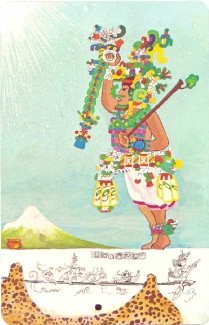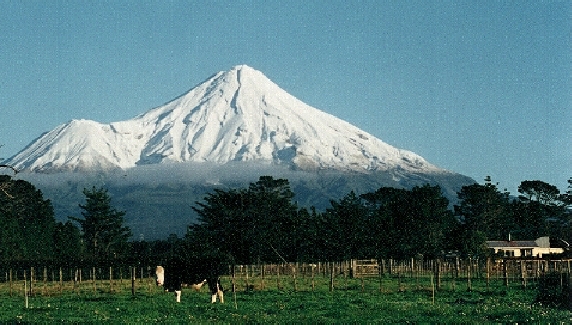© Kahurangi Press 2010-
XULTUN

Sorcerer

Mount Taranaki
ORIGINS
Excerpts from The Maya Book of Life: Understanding the Xultun Tarot
Peter Balin was born near New Plymouth, New Zealand. A self-
Birth
Right in the middle of his protestation: “Something occurred which had never happened to me before in my life, and which is extremely difficult for me to explain. The only way that I can do so is to say that it approximated a colour slide going on in my brain. That is all of a sudden, I was telling her how crazy I thought she was, and the next minute… Voom! I should say about like that, it’s very difficult to describe because it was not quite like that either. But this large thing appeared in my head it seemed, or somewhere inside of me, I just really don’t quite know where.”
The image was of the twenty-
Balin said, “Apparently I had a lot of the qualifications necessary to be able to make this deck. One of [which] was that I knew nothing about the Tarot. Because if I did, obviously I would be tripped up by what I knew. There would be a great battle in my head.… Within a year of the time that the original cards were painted, they were printed and out on the market. Obviously something somewhere felt that it was very important to get these cards out.”
Printing
The first edition of the Xultun Tarot was printed by the George Banta Printing Company in Menasha, Wisconsin in 1976. The cards were larger (136 x 89 mm, 5.5 by 3.5 ins) than those of most other tarot decks. During that year Balin travelled to Mexico on a bus and ended up sitting next to Frank Waters, novelist and author of Book of the Hopi (1963) and Mexico Mystique: The Coming Sixth World of Consciousness (1975), for the six hours of the journey. After he returned to Los Angeles to finish painting the cards he received a postcard from Mexico. It was from Waters and had rounded corners and the single word “Hola!” (Hello! in Spanish) written on it. Balin realised that this postcard would be the ideal size and proportion for the Xultun cards.
The deck came as a boxed set with the major arcana of twenty-
Balin flew to Menasha, Wisconsin to proof the cards prior to printing and ensure the colours were true to his original paintings. (The major arcana was one single painting and the minor arcana were painted in sets of four). But, having been preoccupied with the painting of the cards during the year, he had given little thought to the box. As a result, the design of box in Figure was done at the last moment. Balin was dissatisfied with it and redesigned it in green with a gold feathered serpent winding around the box. He then hand-
Subsequently, these decks were given to the new publisher in Los Angeles, Wisdom Garden Books. The original cards in the brown box are now hard-
For the new 2010 edition Kahurangi Press have faithfully reproduced the cards in their original size and vivid colours. In cooperation with Peter Balin they have redesigned the back of the cards (in cinnabar red with a new feathered serpent design) and the box (green with a blue feathered serpent encircling it).
Naming
Historically, almost all tarot decks were named after their creator but Balin didn’t want the deck named after him. So he made a list of Maya place names and selected Xultun, the name of a Maya site near Tikal in north-
Sometime later, Balin discovered that the word xultun means “a storage place” where the Maya stored water or maize. The limestone of the Yucatan peninsula is so porous that no water collects on the surface. The only sources of water are a few cenotes—deep, steep-
Another other use for the xultun was as a star-
Balin had lived for some months in a small Maya village with many ruins close by. He became familiar with how the local people dressed and the particular way they tied their sashes. He spent the summer of 1972 sketching images at Tikal. The first six figures in the cards (Fool, Sorcerer, Priestess, Consort, Ruler and Priest) are all drawn from wooden lintels in Temple III at Tikal as are the glyphs running across the base of the platform that the last three figures stand on. The glyphs between the second and third rows come from Stela 26 at Tikal. Additional designs are taken from Stelae 1 and 31. A stela (Latin for standing stone) was an upright stone slab or pillar often carved with glyphs. Maya called them tetun, or “tree-
Signing
At the base of the Sorcerer card, in the distance, we see a snow-